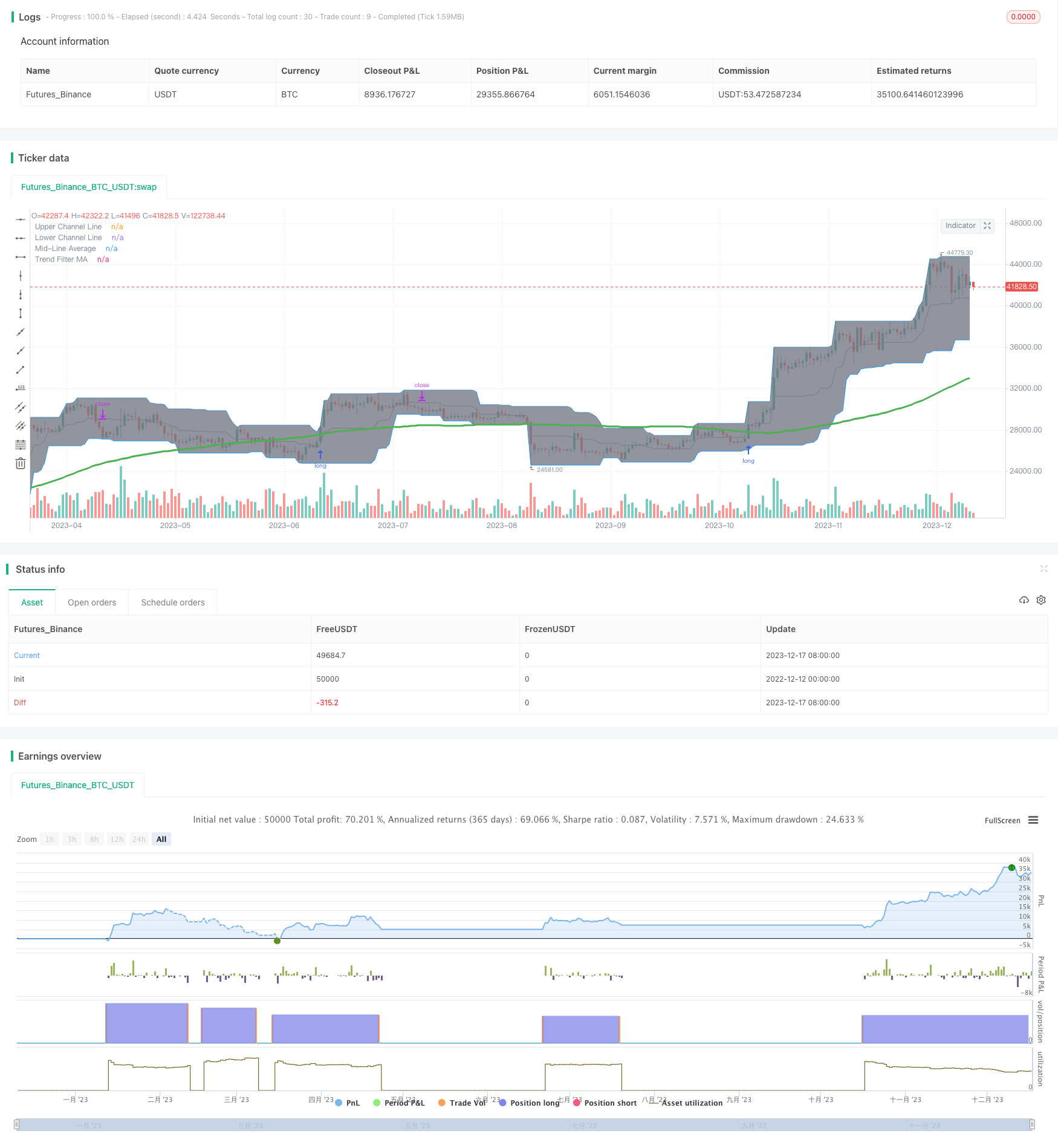
概述
动量突破交易策略(Momentum Breakout Trading Strategy)是一种趋势追踪策略,它通过检测价格突破关键的支撑阻力位来产生交易信号。该策略运用Donchian Channel指标动态确定关键的支撑阻力位,并结合移动平均线指标进一步过滤信号,避免产生错误交易。
策略原理
该策略的核心指标是Donchian Channel。Donchian Channel由最高价、最低价和中线价格组成。通道上轨线和下轨线分别连接一定周期内的最高价和最低价。当价格突破通道上轨时产生买入信号;当价格跌破通道下轨时产生卖出信号。这反映了市场动量的变化。
移动平均线被用来判断价格趋势方向。只有当价格位于移动平均线之上时,突破通道上轨的买入信号才被采纳,这样可以避免买入盘整区域。
具体来说,该策略的入市条件是:价格突破Donchian Channel上轨,且关闭价高于移动平均线。出市条件是:价格跌破Donchian Channel下轨。
止损方式为追踪Donchian Channel下轨。这保证了止损点随着趋势的推移而上移。
优势分析
该策略结合两个指标判断趋势方向和力度,可以有效识别突破signals,避免错误交易。同时,止损方式合理,使得策略可以充分跟踪趋势获利。
具体来说,该策略有以下优势:
Donchian Channel指标可以动态确定关键的支撑阻力位,识别趋势关键转折点。
移动平均线指标作为过滤器,避免买入盘整区域,减少无效交易。
止损方式为追踪Donchian Channel下轨,可以最大限度跟踪趋势获利。
策略参数设置合理灵活,可以针对不同市场环境进行调整优化。
风险分析
该策略主要面临以下风险:
突破失败风险。价格突破通道上轨后可能会快速回调,无法有效建仓。
趋势反转风险。行情可能在止损点之前发生反转,导致止损出场。
参数优化风险。不当的参数设置可能导致交易频繁或信号不足。
针对这些风险,可以通过调整移动平均线周期、增加成交量过滤等方式进行优化,确保产生的信号更加可靠。同时应适当 Loose 一些 Stop Loss 设置来应对短期调整的风险。
优化方向
该策略可以从以下几个方面进行进一步优化:
利用成交量指标过滤信号,确保突破有力。
优化移动平均线周期参数,使其更加符合不同品种的特性。
调整止损机制,使止损距离能够适应行情波动。
增加再入场机制,在止损出场后可以再捕捉趋势机会。
多品种回测,检查参数健壮性。根据不同品种特点微调参数。
总结
动量突破交易策略整合多种指标判断趋势方向和力度,解决常见趋势系统的盲目建仓问题。该策略参数设置灵活,可针对不同行情环境和交易品种进行优化调整,是一种较为通用和实战的突破系统。
/*backtest
start: 2022-12-12 00:00:00
end: 2023-12-18 00:00:00
period: 1d
basePeriod: 1h
exchanges: [{"eid":"Futures_Binance","currency":"BTC_USDT"}]
*/
//@version=4
// Revision: 1
// Author: @millerrh
// Strategy:
// Entry: Buy when Donchian Channel breaks out
// Exit: Trail a stop with the lower Donchian Channel band
// Conditions/Variables:
// 1. Can add a filter to only take setups that are above a user-defined moving average (helps avoid trading counter trend)
// 2. Manually configure which dates to back test
// 3. User-Configurable DC Channel length
// === CALL STRATEGY/STUDY, PROGRAMATICALLY ENTER STRATEGY PARAMETERS HERE SO YOU DON'T HAVE TO CHANGE THEM EVERY TIME YOU RUN A TEST ===
// (STRATEGY ONLY) - Comment out srategy() when in a study()
strategy("Donchian Breakout", overlay=true, initial_capital=10000, currency='USD',
default_qty_type=strategy.percent_of_equity, default_qty_value=100, commission_type=strategy.commission.percent, commission_value=0.1)
// (STUDY ONLY) - Comment out study() when in a strategy()
//study("Donchian Breakout", overlay=true)
// === BACKTEST RANGE ===
From_Year = input(defval = 2019, title = "From Year")
From_Month = input(defval = 1, title = "From Month", minval = 1, maxval = 12)
From_Day = input(defval = 1, title = "From Day", minval = 1, maxval = 31)
To_Year = input(defval = 9999, title = "To Year")
To_Month = input(defval = 1, title = "To Month", minval = 1, maxval = 12)
To_Day = input(defval = 1, title = "To Day", minval = 1, maxval = 31)
Start = timestamp(From_Year, From_Month, From_Day, 00, 00) // backtest start window
Finish = timestamp(To_Year, To_Month, To_Day, 23, 59) // backtest finish window
// == INPUTS ==
trigInput = input(title = "Execute Trades On...", defval = "Wick", options=["Wick","Close"]) // Useful for comparing standing stop orders vs. waiting for candle closes prior to action
stopTrail = input(title = "Trail Stops On...", defval = "ATR", options = ["ATR","Bottom of DC Channel","Midline of DC Channel","Tightest of ATR/Bot DC Channel"])
dcPeriod = input(title="DC period", type=input.integer, defval=20)
// === PLOT THE DONCHIAN CHANNEL ===
// Logic
dcUpper = highest(high, dcPeriod)
dcLower = lowest(low, dcPeriod)
dcMid = avg(dcUpper, dcLower)
// Plotting
dcUplot = plot(dcUpper, color=color.blue, linewidth=1, title="Upper Channel Line")
dcLplot = plot(dcLower, color=color.blue, linewidth=1, title="Lower Channel Line")
dcMidPlot = plot(dcMid, color=color.gray, linewidth=1, title="Mid-Line Average")
fill(dcUplot, dcLplot, color=color.gray, transp=90)
// == FILTERING ==
// Inputs
useMaFilter = input(title = "Use MA for Filtering?", type = input.bool, defval = true)
maType = input(defval="SMA", options=["EMA", "SMA"], title = "MA Type For Filtering")
maLength = input(defval = 100, title = "MA Period for Filtering", minval = 1)
// Declare function to be able to swap out EMA/SMA
ma(maType, src, length) =>
maType == "EMA" ? ema(src, length) : sma(src, length) //Ternary Operator (if maType equals EMA, then do ema calc, else do sma calc)
maFilter = ma(maType, close, maLength)
plot(maFilter, title = "Trend Filter MA", color = color.green, linewidth = 3, style = plot.style_line, transp = 50)
// Check to see if the useMaFilter check box is checked, this then inputs this conditional "maFilterCheck" variable into the strategy entry
maFilterCheck = if useMaFilter == true
maFilter
else
0
// == ENTRY AND EXIT CRITERIA ==
// Trigger stop based on candle close or High/Low (i.e. Wick) - If doing daily timeframe, can do candle close. Intraday should use wick.
trigResistance = trigInput == "Close" ? close : trigInput == "Wick" ? high : na
trigSupport = trigInput == "Close" ? close : trigInput == "Wick" ? low : na
buySignal = trigResistance >= dcUpper[1] // The [1] looks at the previous bar's value as it didn't seem to be triggering correctly without it (likely) DC moves with each bar
sellSignal = trigSupport <= dcLower[1]
buy = buySignal and dcUpper[1] > maFilterCheck // All these conditions need to be met to buy
// (STRATEGY ONLY) Comment out for Study
// This string of code enters and exits at the close
if (trigInput == "Close")
strategy.entry("Long", strategy.long, when = buy)
strategy.close("Long", when = sellSignal)
// This string of code enters and exits at the wick (i.e. with pre-set stops)
if (trigInput == "Wick")
strategy.entry("Long", strategy.long, stop = dcUpper[1], when = time > Start and time < Finish and dcUpper[1] > maFilterCheck)
strategy.exit("Exit Long", from_entry = "Long", stop = dcLower[1])